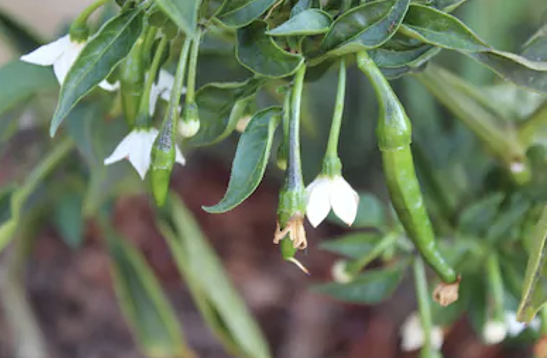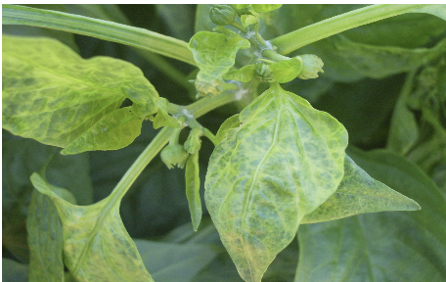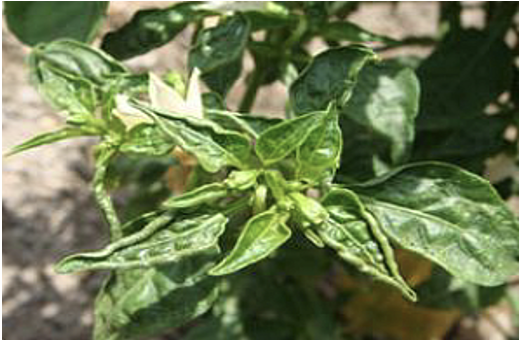🌶 Chilli
Cultivation, Important Point, Pests
- Botanical Name:
Capsicum annum - Family: Solanacae
- Origin: Maxico
- India is largest producer of chillies in the world accounting for 45 % of total area under cultivation.
- Chilli and Capsicum both belong to same family as well as same spp. that is
Capsicum annum. Capsicinis pungent principle found in chilli.- Green chilli retard cancer due to natural enzyme Asperginase
- C. annum and C. fruitescence have white flower while C. pubescence have purple flowers.

- China - major capsicum (Bell pepper) producing country of the world.

Indiais a major producer, consumer and exporter of chilli in the worldAndhra Pradeshis pioneer in chilli production.- Long dry periods are likely to result in flower shedding and fruit fall.
- June - October is the major chili growing period in South India.
- Dry chilli generally contains about 6% stalks + 40% pericarp + 54% seeds.
- 7 g good quality seed provides 100 plants.
- Chilli has bidirectional root system.
- Chilli is richest source of Vitamin C.
Capsicum Varieties
- Introduced
- California wonder
- Yolo Wonder
- World beater
- Chinese Giant
- Golden wonder
- Bullnose
- Sweet Banana
- Selection
- Arka Mohini
- Arka Gaurav
- Arka Basant
- Public Sector Hybrid
- Pusa Deepti
- Green Gold
- Private Sector Hybrid
- Early Bounty
- Bharat
- India
- Lario
- Hira
- Pusa Meghdoot: First F1 hybrid by public sector.
- About 90% of the the capsaicin in chilli has been noticed in placenta, connecting seed with pericarp.

- Anthracnose/die back due to fungus: Colletotrichum capsic
- Vitamin present in chilli is Vitamin P (flavonoids or bioflavonoids).
- NAA (Planofix) @ 10 ppm and Triacontanol is used to control fruit drop.
- Capsicum annum (Shimla Mirch) also known as sweet pepper.
- To prevent fruit rot should be used Calcium nitrate (CN) @ 1 litre/ha or broadcasting about 25 kg/ha.
Seed rate
- For chili: 1.0-1.5 kg/ha
- For capsicum annum (hybrid): 250g seeds/ha
- Sown in nursery and transplanted after 45 days of seedling.
Chilli Varities
- Selection
- Kalyanpur Yellow
- Sabour Angar
- Arka Lohit
- Bhagyalaxmi
- Sindhur
- Hybrid
- G-S
- Bhaskar
- NP-46-A
- Punjab lal
- Pusa Jwala: NP-46-A x Puri Red
- Pant-C-1: NP-46-A x Khandari
- Andhra Jyoti — Cherry type fruits
- Mutant: MDU-1
- Private sector hybrid
- Tejawini
- Champian
- Gayatri
- Agni
- Delhi hot
- Skyline
- Public Sector Hybrid
- CH-1 → Released by PAU - Ludhiana using male sterile line.
- Fruit rot resistant variety K-2.
- Leaf curl resistant variety — Pusa Jwala, Pusa Sadabahar, Pant-C-1
- 15 Irrigations are required in capsicum.
- Leaf curl, TMV, wilt and dieback resistant variety → Punjab Lal, Punjab Surakh → Multiple disease Resistance.
- Bacterial wilt resistant variety → Utkal Rashmi, Arka Gauray.
- Jwalamukhi: Suitable for HDP
- Arka lohit: Tolerant to powdery mildew
- Bhaskar: Yellow anther type, Resistant to thrips and mites
- India’s share in total export of chilli in world is 4%
- Rains during Dec-Nov, result in the incidence of powdery mildew.
- Opening of flower at 5 am.
- Pusa Sadabahar variety of C. fruitescence is perennial in nature.
- 3-10 days for sun drying to lower moisture from 80 to 10%.
- Punjab Lal: for colour extraction.
- HP - leading supplier of capsicum in off season.
- Green to dry chilli ratio = 10 : 1
- Chilli variety - CH-1 → developed by using Genetic Male sterile (GMS) line.
- Excess of N with water stress: Blossom end rot of fruits of capsicum.
- Variety with thin pericarp, less seeds, strong spike is suitable for drying.
Pest management
-
Chilli thrips
- Major pest of chilli is
Thrips(Scirtothrips dorsalis). - Leaf curl of chilies:
Viral, transmitted bythrips. - Symptoms is the inward (upward) curling of leaves

- Major pest of chilli is
-
White flies
- Bemisia tabaci
- It is responsible for transmission of
chilli mosaic virus

- Both white flies and thrips can be managed by spraying of any systemic insecticides i.e. Acephate @ 1.0 ml liter of water. Or Thiomethoxam @ 0.4 ml/liter spray or
- Imidacloprid @ 0.5 ml liter of water with Streptocyclin @ 0.1 g /liter of water.
- Botanical Name:
Capsicum annum - Family: Solanacae
- Origin: Maxico
- India is largest producer of chillies in the world accounting for 45 % of total area under cultivation.
- Chilli and Capsicum both belong to same family as well as same spp. that is
Capsicum annum. Capsicinis pungent principle found in chilli.- Green chilli retard cancer due to natural enzyme Asperginase
- C. annum and C. fruitescence have white flower while C. pubescence have purple flowers.

- China - major capsicum (Bell pepper) producing country of the world.

Indiais a major producer, consumer and exporter of chilli in the worldAndhra Pradeshis pioneer in chilli production.- Long dry periods are likely to result in flower shedding and fruit fall.
- June - October is the major chili growing period in South India.
- Dry …
Become Successful With AgriDots
Learn the essential skills for getting a seat in the Exam with
🦄 You are a pro member!
Only use this page if purchasing a gift or enterprise account
Plan
Rs
- Unlimited access to PRO courses
- Quizzes with hand-picked meme prizes
- Invite to private Discord chat
- Free Sticker emailed
Lifetime
Rs
1,499
once
- All PRO-tier benefits
- Single payment, lifetime access
- 4,200 bonus xp points
- Next Level
T-shirt shipped worldwide

Yo! You just found a 20% discount using 👉 EASTEREGG

High-quality fitted cotton shirt produced by Next Level Apparel